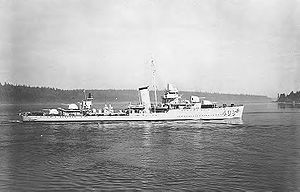- USS Wilson (DD-408)
-

Career (US) 
Namesake: Charles Wilson Builder: Puget Sound Navy Yard Laid down: 22 March 1937 Launched: 12 April 1939 Commissioned: 5 July 1939 Decommissioned: 29 August 1946 Struck: 5 April 1948 Fate: sunk off Kwajalein on 8 March 1948, after atomic testing General characteristics Class and type: Benham-class destroyer Displacement: 2,250 tons (full) Length: 340 ft 9 in (103.9 m) Beam: 35 ft 6 in (10.8 m) Draft: 12 ft 10 in (3.9 m) Propulsion: 50,000 shp,
Westinghouse Geared Turbines,
2 propellersSpeed: 38.5 knots (71.3 km/h) Range: 6500 nmi. (12,000 km)
@ 12 kt (22.2 km/h)Complement: 251 officers and enlisted Armament: 4 × 5 in./38 guns (12 cm),
4 × .50 cal guns,
16 × 21 in. torpedo tubes,
2 × depth charge tracksUSS Wilson (DD-408), a Benham-class destroyer, was the only ship of the United States Navy to be named for Charles Wilson, a seaman in the Union Navy during the American Civil War.
Contents
History
Wilson was laid down on 22 March 1937 at Bremerton, Washington, by the Puget Sound Navy Yard; launched on 12 April 1939; sponsored by Mrs. Edward B. Fenner, the wife of Rear Admiral Edward B. Fenner, the Commandant of the 13th Naval District; and commissioned on 5 July 1939, Lt. Comdr. Russell G. Sturges in command.
Wilson operated along the west coasts of the United States, Central and South America into April 1940, when she went to Hawaii to participate in Fleet Problem XXI. In June 1941, after a year mainly spent in the Hawaiian area, Wilson was transferred to the Atlantic. In the last half of that year, and first months of 1942, she served an escort for major fleet units off the U.S. east coast and, in March-May 1942, steamed across the ocean to Iceland and the British Isles.
Wilson returned to the Pacific as part of a task group centered around Wasp, and accompanied it to the south Pacific in July 1942. Early in the next month, she provided bombardment and anti-aircraft services to the invasion force during landings at Guadalcanal and Tulagi. While in that area on 9 August, Wilson engaged Japanese cruisers during the Battle of Savo Island, and later rescued survivors of the sunken cruisers Quincy, Astoria and Vincennes.
Following a west coast overhaul, Wilson was back off Guadalcanal in January 1943, in time for the last weeks of the fighting there. She subsequently participated in landings on the Russell Islands, bombarded enemy positions on New Georgia and escorted shipping in and around the Solomon Islands. In November 1943, the destroyer screened U.S. aircraft carriers during strikes on Rabaul and Nauru and was similarly employed during attacks on the Marshall and Caroline Islands in January and February 1944.
In June and July 1944, Wilson served with the carrier task forces during the Marianas Campaign and the Battle of the Philippine Sea, and also fired her guns at small craft and shore targets at Guam. After overhaul work in August-October 1944, she battled enemy suicide planes in late December while escorting a convoy to Mindoro, in the central Philippines. The next month, Wilson again engaged hostile aircraft and shore positions during the Lingayen Gulf invasion. On 16 April 1945, during the campaign for Okinawa, she was hit by a kamikaze, which cost the lives of five of her crewmen and left an unexploded bomb in her after hull. Soon repaired, she served in the Okinawa area until June and operated out of Saipan until the war ended in August.
Wilson was employed on occupation duty until December 1945, when she returned to the U.S. west coast. In May of the next year, she was assigned to Operation Crossroads target duty. Made radioactive by the July atomic bomb tests at Bikini, Wilson was decommissioned in August 1946 and sunk in deep water off Kwajalein on 8 March 1948.
Honors
Wilson received 11 battle stars for her service during World War II
References
This article includes text from the public domain Dictionary of American Naval Fighting Ships. The entry can be found here.
External links
- history.navy.mil: USS Wilson
- history.navy.mil: USS Wilson Photos
- navsource.org: USS Wilson
- hazegray.org: USS Wilson
Preceded by: Somers class - Followed by: Sims class
Categories:- Benham class destroyers
- World War II destroyers of the United States
- Ships damaged by kamikaze attack
- Ships built in Washington (state)
- 1939 ships
Wikimedia Foundation. 2010.
